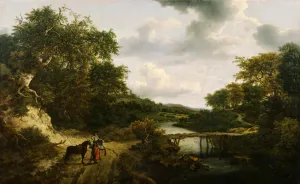Ruisdael
Jacob van Ruisdael (1628/29–1682)
Landscape with a Footbridge, 1652
Oil on canvas
38 3/4 x 62 5/8 in. (98.4 x 159.1 cm)
Purchased by The Frick Collection, 1949
Accession number: 1949.1.156
For more information, see Landscape with a Footbridge
Collections: Samuel Ireland, London, by 1786. John Calvert Wombwell, London, by 1854; K. Papin, Paris (Drouot), March 28–29, 1873, no. 26 (fr. 61,000); Baron Albert von Rothschild , Vienna; inherited by his son Baron Louis Nathaniel von Rothschild ; confiscated by the Nazis soon after the German annexation of Austria, March 12, 1938; returned to Baron Louis von Rothschild after World War II; sold through Rosenberg & Stiebel, New York (agents for the Rothschild family); purchased by The Frick Collection, 1949.
After annexing Austria in March of 1938, Adolf Hitler instituted a program for confiscating artworks from Jewish collectors, allocating many of the works to his never realized Führermuseum. He particularly focused on the rich art collections in Vienna. Among the works confiscated was Ruisdael’s Landscape with a Footbridge, which belonged to Baron Louis Nathaniel von Rothschild, a member of the Viennese branch of the Rothschild banking dynasty. Unlike fellow family members who managed to flee the country, Louis von Rothschild remained in Vienna after the annexation of Austria and was detained by the Nazis. Imprisoned for more than a year, he was only able to obtain his freedom by surrendering all of the Rothschilds’ possessions. It is estimated that his collection alone may have comprised more than a thousand paintings.
At the war’s end, Landscape with a Footbridge was restituted to Louis von Rothschild along with other works from his collection. Though the painting’s whereabouts during the war are unknown, it is believed to have been recovered from salt mines in the alpine village of Altaussee, where the Nazis stored thousands of confiscated artworks for safekeeping. In 1945, the Monuments Men extracted this enormous cache of artworks, which included objects belonging to Louis von Rothschild and his late brother Alphonse Mayer von Rothschild. In 1949, the Rothschild family sold the Ruisdael painting to The Frick Collection through the New York gallery Rosenberg & Stiebel. It was the second painting by Ruisdael to enter the collection, the first being Quay at Amsterdam, a small harbor scene acquired in 1910. Landscape with a Footbridge is often hung in the Frick’s West Gallery, where it can be enjoyed among the many Dutch Golden Age masterpieces collected by Henry Clay Frick.
Landscape with a Footbridge demonstrates Ruisdael’s special gift for rendering subtle effects of light: the pale sun filters through the clouds, dappling the landscape and gleaming off the surface of the stream. The realistic treatment of the gnarled oak tree at left is typical of his careful observation of nature. The figures, which provide a sense of scale, were likely added by another hand, as was Ruisdael’s usual practice. Although the exact locality of this landscape has not been determined, the hilly conformation of the countryside, as well as the date of the work, suggests that the site may have been in the province of Overijssel, near the Dutch-German frontier, which Ruisdael visited in 1650. Previously, most of his depictions of the countryside had been of the flatter terrain of central Holland.
Sources:
Alford, Kenneth D. Hermann Göring and the Nazi Art Collection: The Looting of Europe’s Art Treasures and Their Dispersal after World War II. Jefferson, North Carolina, and London: McFarland & Company, Inc., 2012.
Art in The Frick Collection: Paintings, Sculpture, Decorative Arts. New York: Harry N. Abrams, 1996.
Edsel, Robert M. The Monuments Men: Allied Heroes, Nazi Thieves, and the Greatest Treasure Hunt in History. New York: Center Street, 2009.
Müller, Melissa, and Monika Tatzkow. Lost Lives, Lost Art: Jewish Collectors, Nazi Art Theft, and the Quest for Justice. New York: Vendome Press, 2010, pp. 198–215.
Paintings in The Frick Collection: American, British, Dutch, Flemish and German. Vol. 1. New York: The Frick Collection, 1968.
Petropoulos, Jonathan. Art as Politics in the Third Reich. Chapel Hill: University of North Carolina Press, 1996.
Slive, Seymour. Jacob van Ruisdael: A Complete Catalogue of His Paintings, Drawings and Etchings. New Haven and London: Yale University Press, 2000, pp. 373–75.


